The Border-Gavaskar series analysis. This series was so intense that every player from both teams were tactical and technical challenged by the pitch. The demands of these challenges resulted in verbal battle between teams. The first test loss riled India so much that their players and captain never gave any credit to Australia in how they performed.
India are No. 1 test team, and will remain at the top for some time, because they hardly travel overseas, at home there are no recent series to be played.
–when touring India teams will be faced with tactical/technical challenges, physical and mentally the demands will be very high. If teams can maintain discipline in the entire series, than they can win.
In future teams that travel to India only have to look how Australians have performed in this Border-Gavaskar series.
However one feels it was Australia that showed all teams including India-how to play in Asia!. They surely have breached the fortress. Teams that have great discipline, adaptive-skills and character that it is not difficult to win a test series in India.
In bowling – they need to restrain from bowling short and wide – the length becomes the key for all type of bowling here in India. Anything wide and short will only allow batsman to stay long and score easily
Backing their bowling should be their sharp fielding(game’s ignored part).Catches particular at close-in field is very vital for bowlers. Here they can produce great momentum for teams to restrict big score, and allow teams to go deep into the test match.
In Batting – here they need to constrain their mind from playing horizontal shots – especially the cut shot – It is easy to get carried by fast out-field, but the variable bounce will be the short coming.
Below I have done detailed statistical analysis of –
a) Fielding Zone : analysis on saved runs, allowed runs, catches/stumping taken, dropped – zone –
b)Batting analysis on – Horizontal/Vertical shots
c) Length analysis – For each test match.
d) Bowling analysis – category and trajectory
e) List of players performance (batting/bowling) of both teams.
Field-zone. An analysis on fielding skills in each zone.
This analysis features fielding performance, viz runs saved, allowed, catches taken, dropped, stumping dismissals and missed.Australia finished ahead in the fielding skills. They created more opportunities by saving more runs than allowing runs and took more catches than dropping one.
| Below columns have lists of indicators that reflects fielding performance. Field-zone is divided into 2 groups. Close-in and deep field. |
|---|
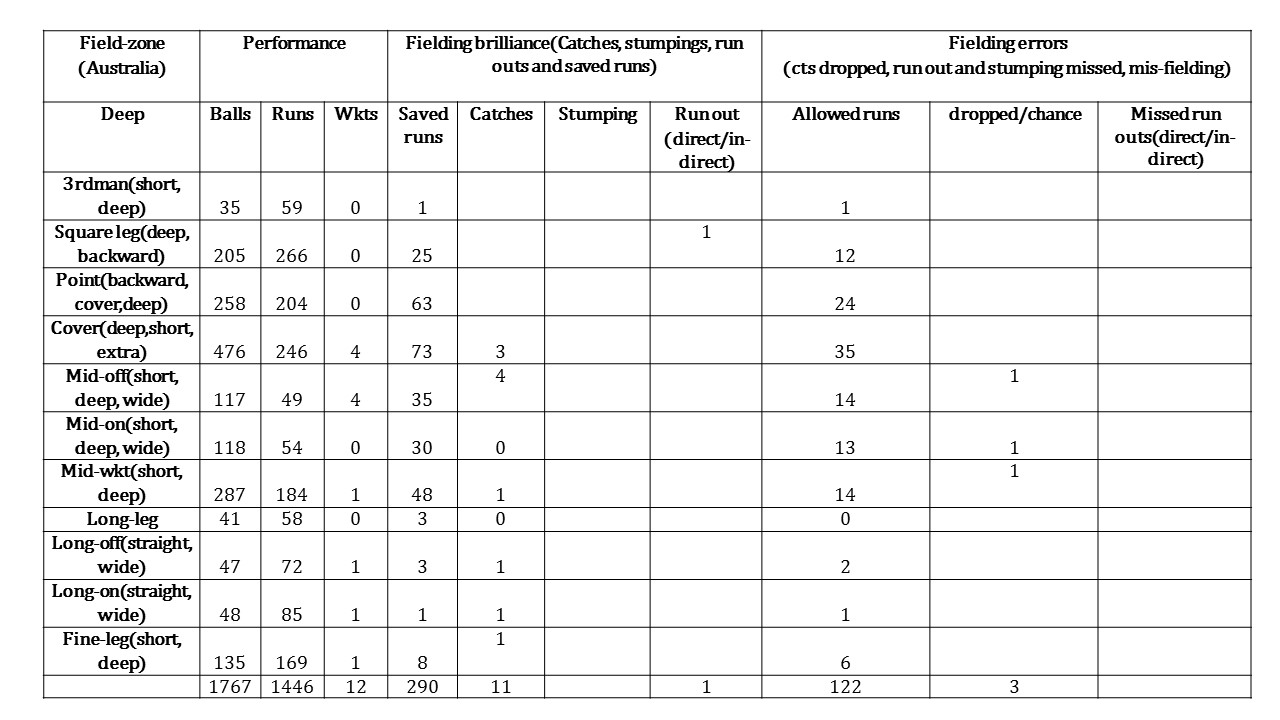 |
| Close in |
 |
| Indian fielding performance. Deep zone |
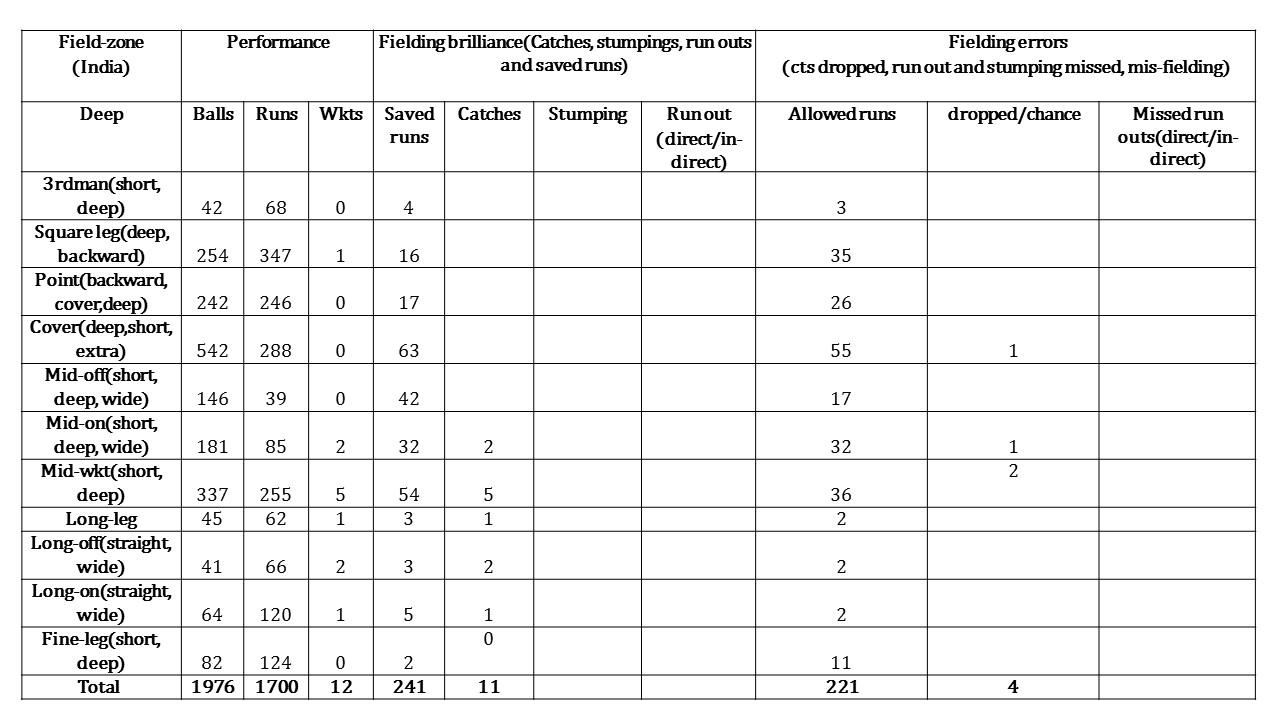 |
| close-in |
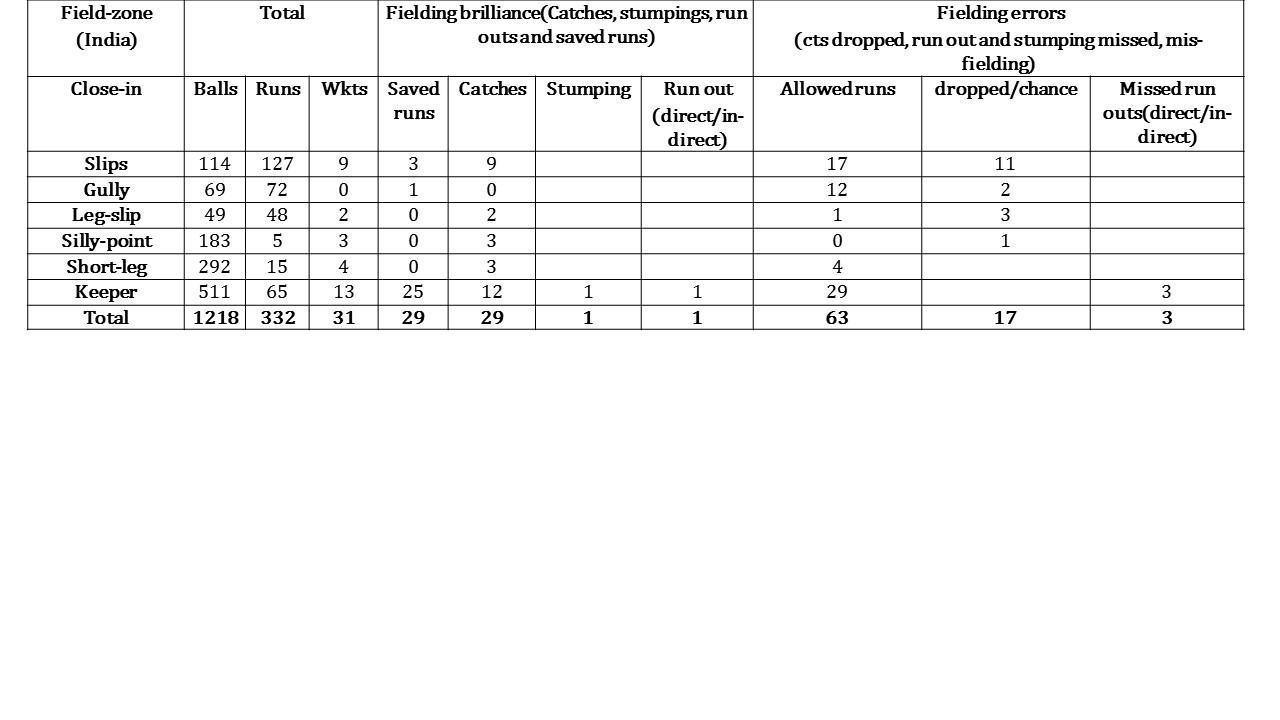 |
Batting skill and technique (horizontal/vertical play)
A batsman is defined by how he plays against various type of bowling on given condition. He needs to train himself as he cannot control type of bowling and condition given to him.Australia knew their skill to play spin in Asia is far less than their host or any other Asian team. Therefore their batsmen disciplined themselves from playing horizontal shot, and bowlers constrained themselves from bowling short of length consistently.
The pitch for the 4th Test at Dharmsala was similar to previous tests, but had more bounce, that probably must have brought smile on to their faces inducing them to play horizontal and bowl shorter. The luck of coin favoured them and they were off to a rousing start with Warner playing his best innings of the series.
However they failed to capitalise that start and were bundled out for far less anticipated score by end of day one. They fritter away their chances and apart from captain Smith no batsman took advantage of the pitch or the start they got.
Before the 4th test -Only 6(10.71%) Australian were dismissed to a ball that was above waist height, but in the 4th test 6 were (30%) were dismissed above waist height -suggesting they were lured by the bounce and were not able to discipline themselves. Smith was an perfect example, who looked good in the 2nd innings, and then got out playing a poor pull shot. Australia hopes of scoring big swiftly disappeared and India only needed 106 to win the test and series.
They did had a small target to chase which was achieved with great panache from their stand-in captain Rahane. India won the test and the series. It was a fitting and fighting win for India as they had great help from the surface they produce to play.
| The vertical play was the most successful yet safe shot for both teams in this series. However it was hardly employed by batsmen. Here is what happened in this series. Australian batsmen faced 4326 balls – off which only 12.90% balls (557) were played with Vertical bat- producing 31.50% runs (638) from their total runs(2025) - lost 14(76) wkts. India on the other hand faced far less 3567 balls – off which 11.40% of balls(408) were played with Vertical bat- producing 28.26% runs (485) from their 1716 runs – lost 12 (61)wkts. |
|---|
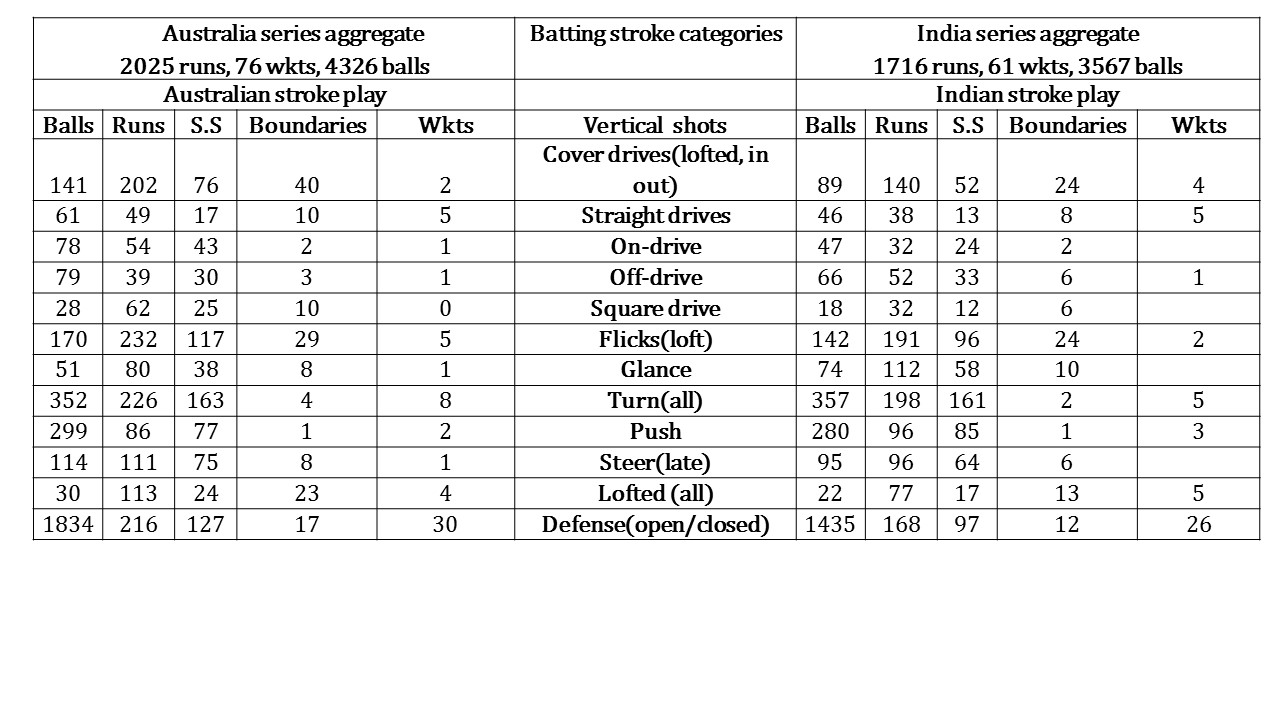 |
 |
The Length: The most important aspect of over-arm bowling
Below table features data on length bowled by fast bowlers and spinners in each test of the series. List of indicators are balls faced, runs scored, scoring shots, wickets, and error made by batsmen.| The Pune test 75% updated. | |
|---|---|
 |  |
 | 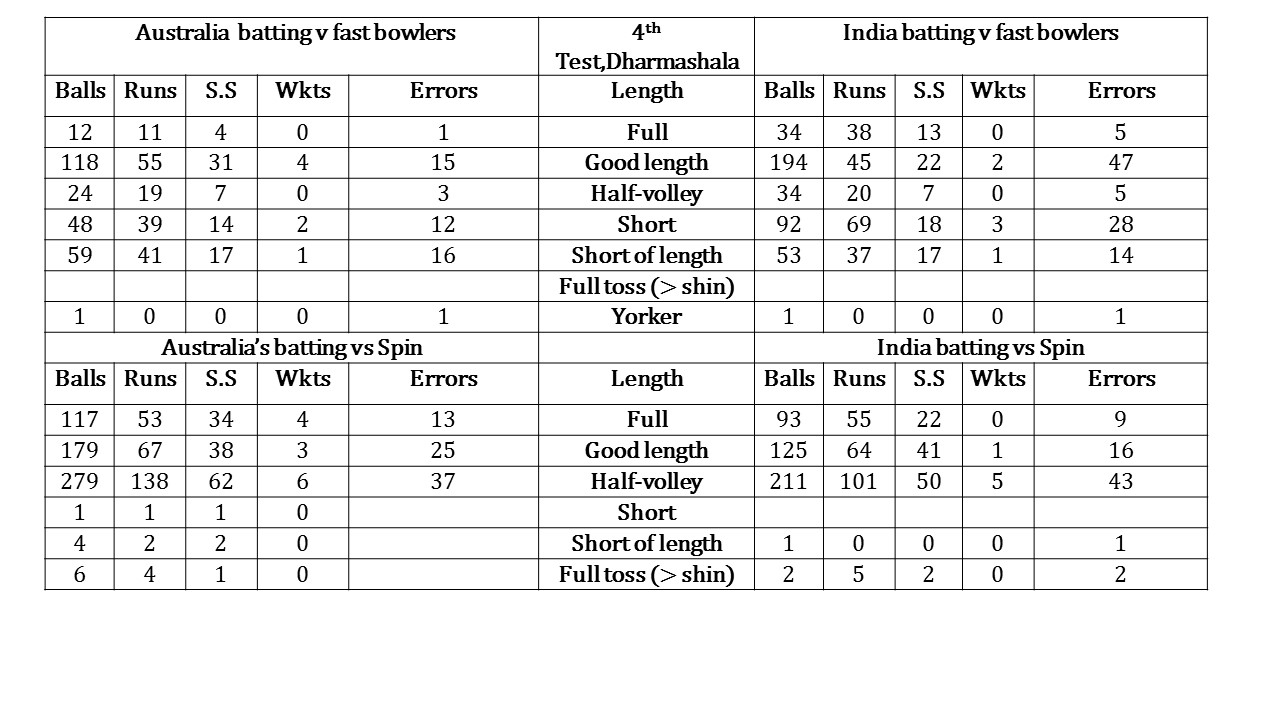 |
Bowling category
Below table features stats based on type of balls bowled by fast bowlers and spin bowlers. The column indicators are balls, wickets and error made by batsmen. India used 3 different type of spinners(off-spinners, left-arm spinner, slow-chinaman googly) and right arm fast bowlers. Australia used two type of spinners(off-spinners & left-arm spinner) and two type of fast bowlers(right arm and left arm).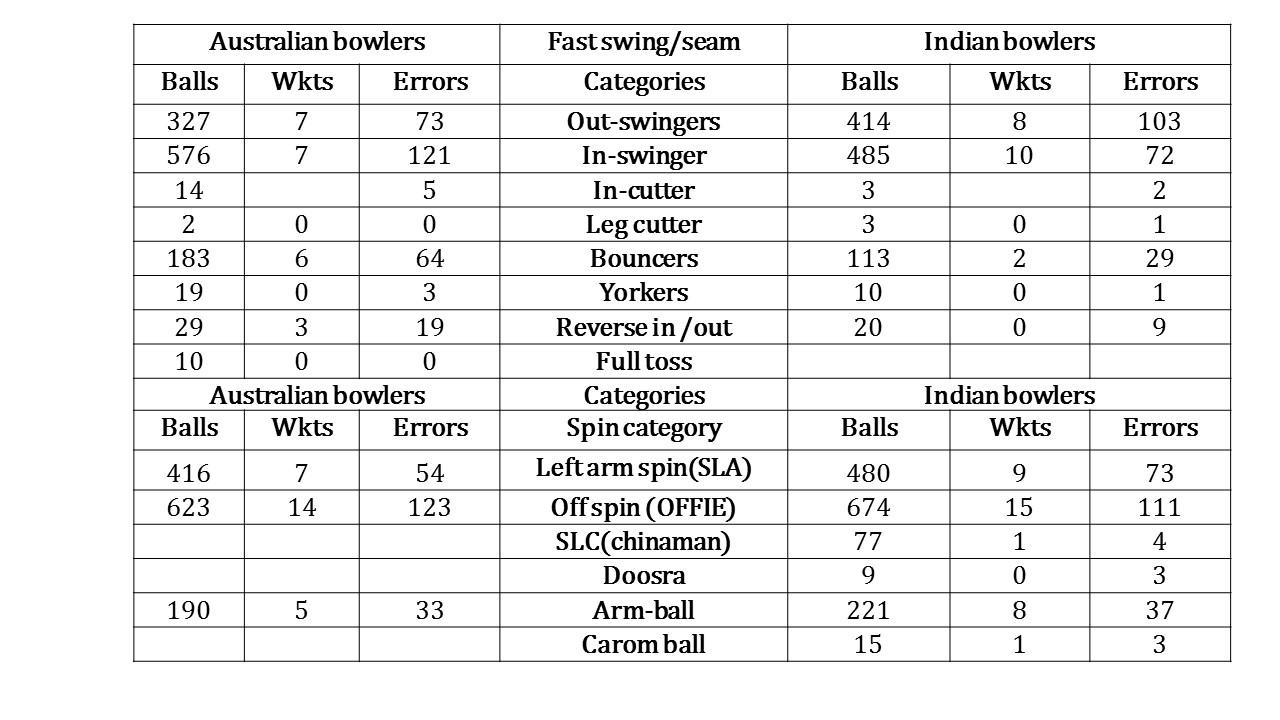 |  |
|---|
A brief guide to player’s performance(batting/bowling/fielding)
Surprisingly Virat Kohli was a flop with the bat for India. This led to the most surprising aspect of Indian team "Did captain Kohli bowed to batsman Kohli ?." As one thought he should have fielded when he was injured, probably from a safest fielding zone!. This would probably inspired his team and perhaps Australia could have been bowled out cheaply. However he decided to rest himself as he seems to be more concern of his batting than leading India.For India Chetashwar Pujara scored the most runs featuring a double century. He has an impressive batting average at home 63.56. However when he plays in unknown condition(non-Asian venues) than his average falls down to 29.40 . In 14 Tests that he played in ENG, SA, NZ, AUS -he has only scored one century(in SA) and 3 fifties. He and K Rahul held the batting together and were well supported by Rahane and Saha
For Australia Steve Smith their leader stood out as the top batsman. He scored the most runs in the series(499). His role-play stats was probably the highest in a test series by any batsman in recent past. His personal contribution with the bat was 499 runs, and sum of all partnerships in which he was involved accumulated 1014 runs (50.05%) half of total teams score(2025) in the series.
However his deputy David Warner fared poorly with the bat. He was not able to convert his starts to big score. Someone who has played so much cricket in India and has an excellent limited over record in Asia- was not able to adapt to condition and the bowling - managed only one fifty. Now his test record in Asia has gone down to 30.38 in 13 Tests – featuring one century and five fifty.
| Below table reflects batting performance – I have added two new indicators. a) Error % : - indicating No. of errors made by a batsman in an innings. The calculation is -Total balls faced /No. errors x 100 E.g In this series Australia made less batting error(629) in facing 4326 balls = 629*100/4326 =14.54% b) Chances received : When a batsman gets a life(catches dropped, stumping missed, run-out missed). The calculation is No. of chance x 100/(total balls-dismissals). E.g – in this series India marginally received more chances (23) –in facing 3567 balls (23/3567 x 100 =0.66% ) |
|---|
 |
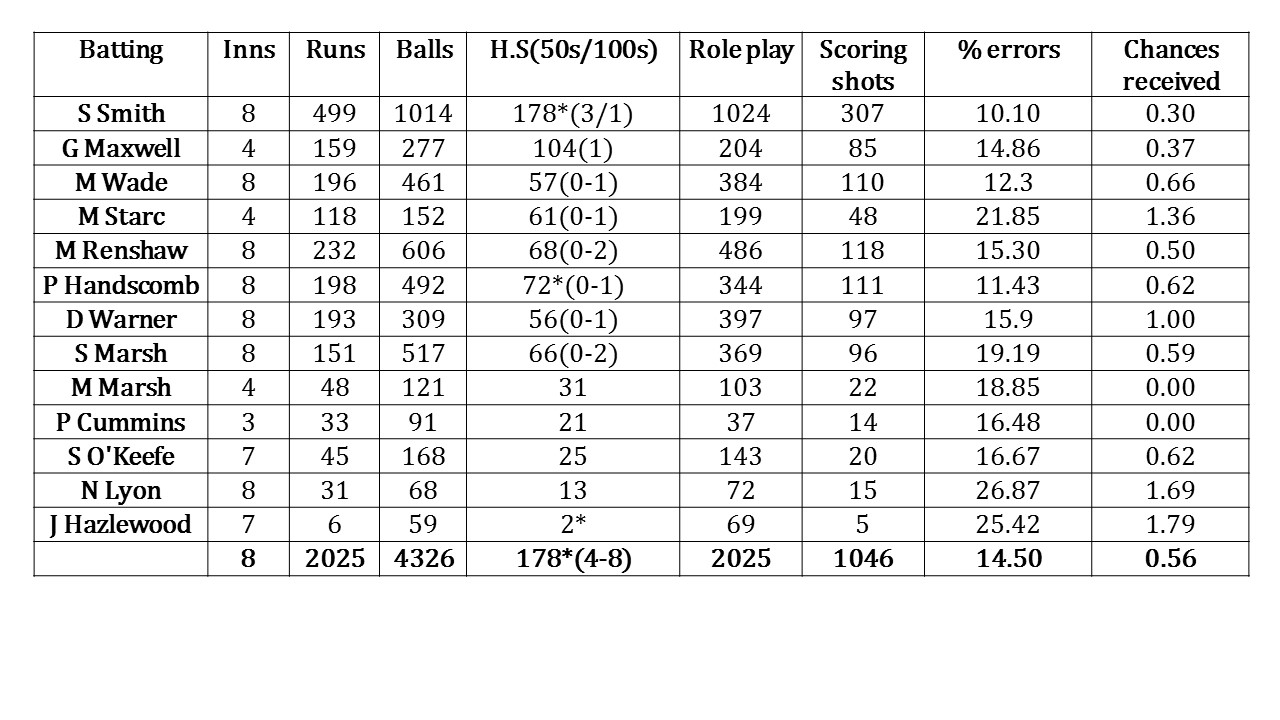 |
To conclude this post it was disappointing to see not a single member of the Indian team (including their captain) gave credit to Australia’s sterling performance in post match interview, not even after the first test defeat- On the other hand Steve Smith was gracious enough to acknowledge India’s performance. It only showed the stranglehold Australia had over India throughout the series….not even England, NZ or South Africa had this hold.
Here is a link to part I- http://allthatcricket.com/452-fortress-breached-australia-showed-the-path/
Link to whether fortress can be breached- http://allthatcricket.com/?p=12542

